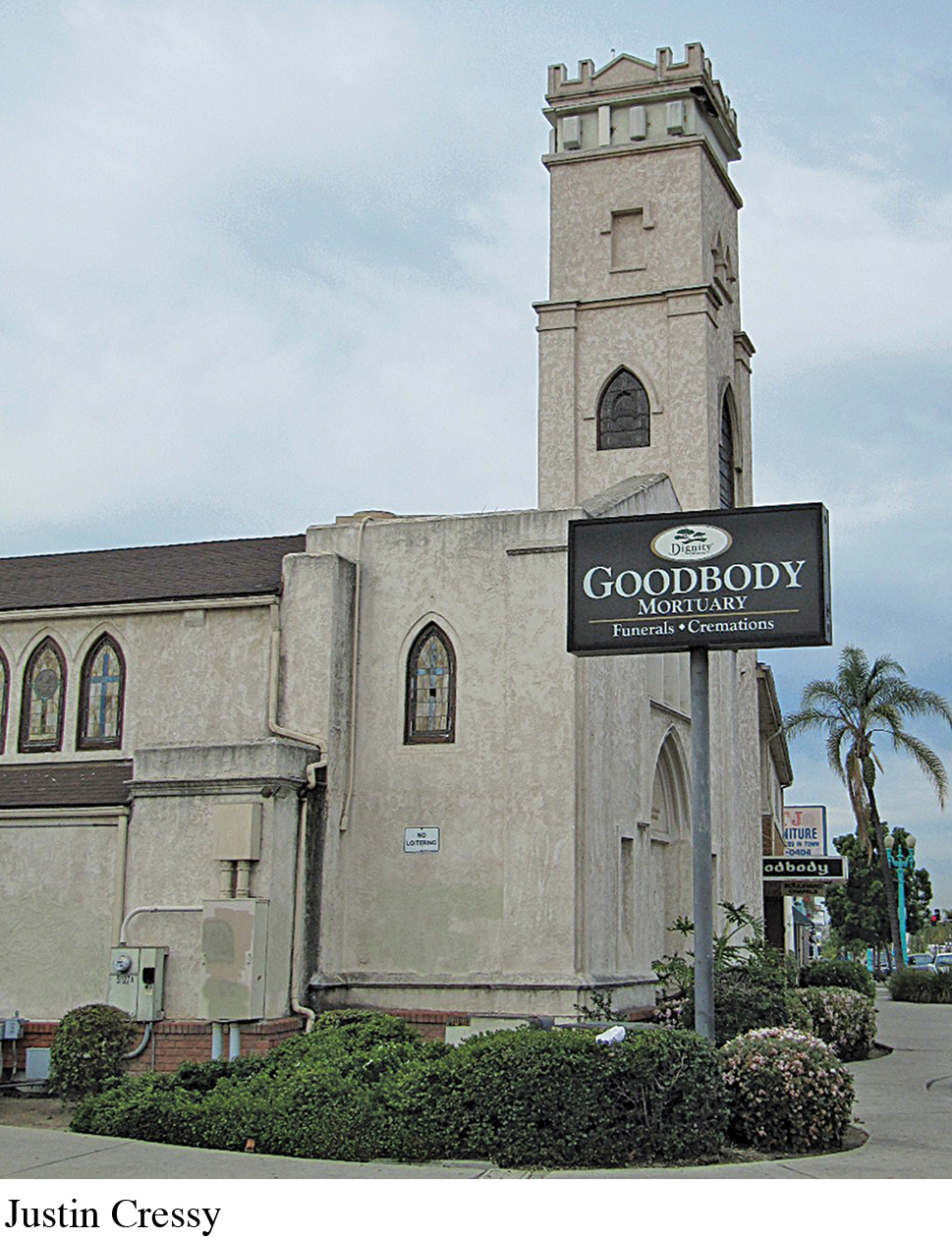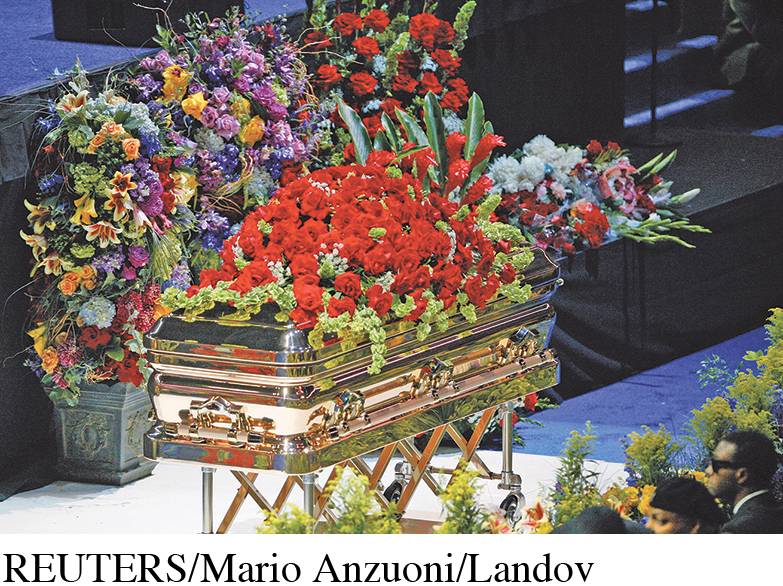Instructor's Notes
- Use the questions in the margin of Brian Cable's essay to stimulate class discussion, or assign groups to answer certain questions and report back to the class.
- These questions are categorized by basic feature in the Instructor's Resource Manual.
- Point out that the “A Writer at Work” section (later in this chapter) shows a portion of Cable's revision process.
Brian Cable The Last Stop
To learn how Cable conducted his interview with the funeral director and wrote up his notes, turn to “A Writer at Work” later in this chapter. Compare the write-
This profile of a neighborhood mortuary was originally written when Brian Cable was a first-
As you read,
notice how Cable uses humor to defuse the inherent seriousness of his subject.
consider the significance of the quotation from Mark Twain with which Cable opens his profile.
answer the questions in the margin. Your instructor may ask you to post your answers to a class blog or discussion board or to bring them to class.
![]() Basic Features
Basic Features
Specific Information
A Clear, Logical Organization
Writer’s Role
A Perspective on the Subject
Let us endeavor so to live that when we come to die even the undertaker will be sorry.
— Mark Twain, Pudd’nhead Wilson
1
Death is a subject largely ignored by the living. We don’t discuss it much, not as children (when Grandpa dies, he is said to be “going away”), not as adults, not even as senior citizens. Throughout our lives, death remains intensely private. The death of a loved one can be very painful, partly because of the sense of loss, but also because someone else’s mortality reminds us all too vividly of our own.
2
More than a few people avert their eyes as they walk past the dusty-
Cable tells us what he expected. How does the opening—
3
It wasn’t at all what I had expected. I thought it would be more like Forest Lawn, serene with lush green lawns and meticulously groomed gardens, a place set apart from the hustle of day-

What organizational plan for the profile emerges in pars. 4 and 5?
4
I was apprehensive as I climbed the stone steps to the entrance. I feared rejection or, worse, an invitation to come and stay. The door was massive, yet it swung open easily on well-
What does the detailed description of Deaver in pars. 5 and 6 contribute to Cable’s profile of the mortuary?
5
I found the funeral director in the main lobby, adjacent to the reception room. Like most people, I had preconceptions about what an undertaker looked like. Mr. Deaver fulfilled my expectations entirely. Tall and thin, he even had beady eyes and a bony face. A low, slanted forehead gave way to a beaked nose. His skin, scrubbed of all color, contrasted sharply with his jet black hair. He was wearing a starched white shirt, gray pants, and black shoes. Indeed, he looked like death on two legs.
What role has Cable adopted in writing the profile? When does it become clear?
6
He proved an amiable sort, however, and was easy to talk to. As funeral director, Mr. Deaver (“Call me Howard”) was responsible for a wide range of services. Goodbody Mortuary, upon notification of someone’s death, will remove the remains from the hospital or home. They then prepare the body for viewing, whereupon features distorted by illness or accident are restored to their natural condition. The body is embalmed and then placed in a casket selected by the family of the deceased. Services are held in one of three chapels at the mortuary, and afterward the casket is placed in a “visitation room,” where family and friends can pay their last respects. Goodbody also makes arrangements for the purchase of a burial site and transports the body there for burial.
Why do you think Cable summarizes the information in par. 6 instead of quoting Howard?
7
All this information Howard related in a well-
8
“I think we’ll be able to get him in by Friday. No, no, the family wants him cremated.”
What does this observation reveal about Cable’s perspective?
9
His tone was that of a broker conferring on the Dow Jones. Directly behind him was a sign announcing “Visa and MasterCard Welcome Here.” It was tacked to the wall, right next to a crucifix.
Why do you think Cable quotes Howard in par. 10 instead of paraphrasing or summarizing?
10
“Some people have the idea that we are bereavement specialists, that we can handle emotional problems which follow a death: Only a trained therapist can do that. We provide services for the dead, not counseling for the living.”
What does this observation contribute to the dominant impression?
11
Physical comfort was the one thing they did provide for the living. The lobby was modestly but comfortably furnished. There were several couches, in colors ranging from earth brown to pastel blue, and a coffee table in front of each one. On one table lay some magazines and a vase of flowers. Another supported an aquarium. Paintings of pastoral scenes hung on every wall. The lobby looked more or less like that of an old hotel. Nothing seemed to match, but it had a homey, lived-
12
“The last time the Goodbodies decorated was in ’99, I believe. It still makes people feel welcome.”
13
And so “Goodbody” was not a name made up to attract customers but the owner’s family name. The Goodbody family started the business way back in 1915. Today, they do over five hundred services a year.
14
“We’re in Ripley’s Believe It or Not, along with another funeral home whose owners’ names are Baggit and Sackit,” Howard told me, without cracking a smile.
How does Cable make the transition from topic to topic in pars. 15–18?
15
I followed him through an arched doorway into a chapel that smelled musty and old. The only illumination came from sunlight filtered through a stained glass ceiling. Ahead of us lay a casket. I could see that it contained a man dressed in a black suit. Wooden benches ran on either side of an aisle that led to the body. I got no closer. From the red roses across the dead man’s chest, it was apparent that services had already been held.
16
“It was a large service,” remarked Howard. “Look at that casket—
17
I guess it was. Death may be the great leveler, but one’s coffin quickly reestablishes one’s status.
18
We passed into a bright, fluorescent-
What does the comparison to a new-
19
“We have models for every price range.”
20
Indeed, there was a wide variety. They came in all colors and various materials. Some were little more than cloth-
21
This was a solid bronze casket, its seams electronically welded to resist corrosion. Moisture-
Where does the information in pars. 22–23 come from? How can you tell?
22
A proper funeral remains a measure of respect for the deceased. But it is expensive. In the United States, the amount spent annually on funerals is around $12 billion (Grassley), with the average price about $7,000 (“NFDA Releases”)—not counting the burial plot. Among ceremonial expenditures, funerals are second only to weddings. As a result, practices are changing. Howard has been in this business for forty years. He remembers a time when everyone was buried. Nowadays, with burials costing more than $7,000 a shot (Grassley), people often opt instead for cremation—

Why do you think Cable uses a rhetorical question here?
23
For Tim, Goodbody’s licensed mortician, the answer is very definitely yes. Burials will remain in common practice, according to the slender embalmer with the disarming smile, because they allow family and friends to view the deceased. Painful as it may be, such an experience brings home the finality of death. “Something deep within us demands a confrontation with death,” Tim explained. “A last look assures us that the person we loved is, indeed, gone forever.”
Whose perspective does this statement reflect? How do you know?
24
Apparently, we also need to be assured that the body will be laid to rest in comfort and peace. The average casket, with its innerspring mattress and pleated satin lining, is surprisingly roomy and luxurious. Perhaps such an air of comfort makes it easier for the family to give up their loved one. In addition, the burial site fixes the deceased in the survivors’ memory, like a new address. Cremation provides none of these comforts.
Is Tim’s definition of mortuary science helpful? Why or why not?
25
Tim started out as a clerk in a funeral home but then studied to become a mortician. “It was a profession I could live with,” he told me with a sly grin. Mortuary science might be described as a cross between pre-
Which information in par. 26 comes from observation and which comes from interviewing Tim? How do you know?
26
Tim let me see the preparation, or embalming, room, a white-
27
I asked Tim if his job ever depressed him. He bridled at the question: “No, it doesn’t depress me at all. I do what I can for people and take satisfaction in enabling relatives to see their loved ones as they were in life.” He said that he felt people were becoming more aware of the public service his profession provides. Grade-
How effective is this ending?
28
Before leaving, I wanted to see a body up close. I thought I could be indifferent after all I had seen and heard, but I wasn’t sure. Cautiously, I reached out and touched the skin. It felt cold and firm, not unlike clay. As I walked out, I felt glad to have satisfied my curiosity about dead bodies, but all too happy to let someone else handle them.
Works Cited
Grassley, Chuck. Opening remarks. Joint Hearing on Pension Tension: Does the Pension Benefit Guaranty Corporation Deliver for Retirees, United States, Senate, Special Committee on Aging and the Committee on Small Business, Government Printing Office, 21 Sept. 2000, www.aging.senate.gov/
“NFDA Releases Results of Member General Price List Survey.” National Funeral Directors Association, 1 Aug. 2013, nfda.org/
Russell, John. “Batesville Casket Is Coy about Starring Role in Jackson Funeral.” ABC News, 9 July 2009, abcnews.go.com/
Twain, Mark. Pudd’nhead Wilson. Pocket Books, 2004, p. 45.